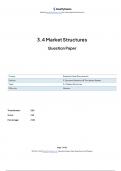Head to savemyexams.co.uk for more awesome resources
3.4 Market Structures
Question Paper
Course Edexcel A Level Economics A
Section 3. Business Behaviour & The Labour Market
Topic 3.4 Market Structures
Difficulty Medium
Time allowed: 200
Score: /161
Percentage: /100
Page 1 of 22
© 2015-2023 Save My Exams, Ltd. · Revision Notes, Topic Questions, Past Papers
, Head to savemyexams.co.uk for more awesome resources
Question 1a
Extract A
The case for nationalisation
Privatisation has not made the rail industry cheaper to operate, despite the promise from one government source that it
would see private companies bringing: “more competition, greater efficiency and a wider choice of services”.
One reason, suggest the critics, is fragmentation. Instead of pushing British Rail into the private sector as a single supplier
the government chose to break it into three components of track, train operators and rolling stock i.e. the trains and
carriages. This has encouraged each part of the rail industry to prioritise its own profits rather than collaborating to improve
the system.
Privatisation, meanwhile, never really worked. The rail network of 2 500 stations and 32 000 km of tracks was renationalised
in 2001. This has encouraged the government’s transport secretary, a supporter of private sector involvement, to argue that
the state Network Rail monopoly should be removed so that companies can bid to build new rail lines to upgrade the railway.
The privately-owned train operators are now the subject of fierce criticism, due to overcrowding and cancelled services.
Private companies are supposed to compete to win a bid to be the train operator for a region for a short number of years.
However in recent years the number of private companies bidding or renewing their contract as rail operators has fallen. In
May 2018 the government rescued the East Coast line by renationalising it. The line had been run by the private rail operator
Virgin Rail, which was suffering lower passenger numbers and revenue than forecast.
Some argue that there is a simple solution: reunite track and train in the only feasible manner, nationalisation.
(Source adapted from: https://www.ft.com/content/d82848ca-f7ba-11e7-88f7-5465a6ce1a00)
(a)
With reference to Extract A, paragraph 3, discuss whether the rail network can be considered to be a natural monopoly.
[1 mark]
Question 1b
Figure 3: Price of a single off-peak train journey, Edinburgh to Leeds Saturday 22nd December 2018 19:00 hours.
Adult Young Persons (16–25) Railcard
£105.30 £69.50
(Source: https://www.lner.co.uk/buy-tickets/booking-engine)
(b)
Discuss the likely benefits of price discrimination to rail passengers. Use a diagram to support your answer.
[1 mark]
Page 2 of 22
© 2015-2023 Save My Exams, Ltd. · Revision Notes, Topic Questions, Past Papers
, Head to savemyexams.co.uk for more awesome resources
Question 2
Amazon.com, the giant online retailer, has too much power’. It uses its market power to put a squeeze on publishers, in effect
driving down the prices it pays for books. If a publisher refuses, Amazon may take action by ‘delaying their delivery, raising
their prices, and steering customers to other publishers’.
(Source adapted from: https://www.nytimes.com)
Evaluate the likely costs of a monopsony operating in a market such as book retailing.
[25 marks]
Page 3 of 22
© 2015-2023 Save My Exams, Ltd. · Revision Notes, Topic Questions, Past Papers




